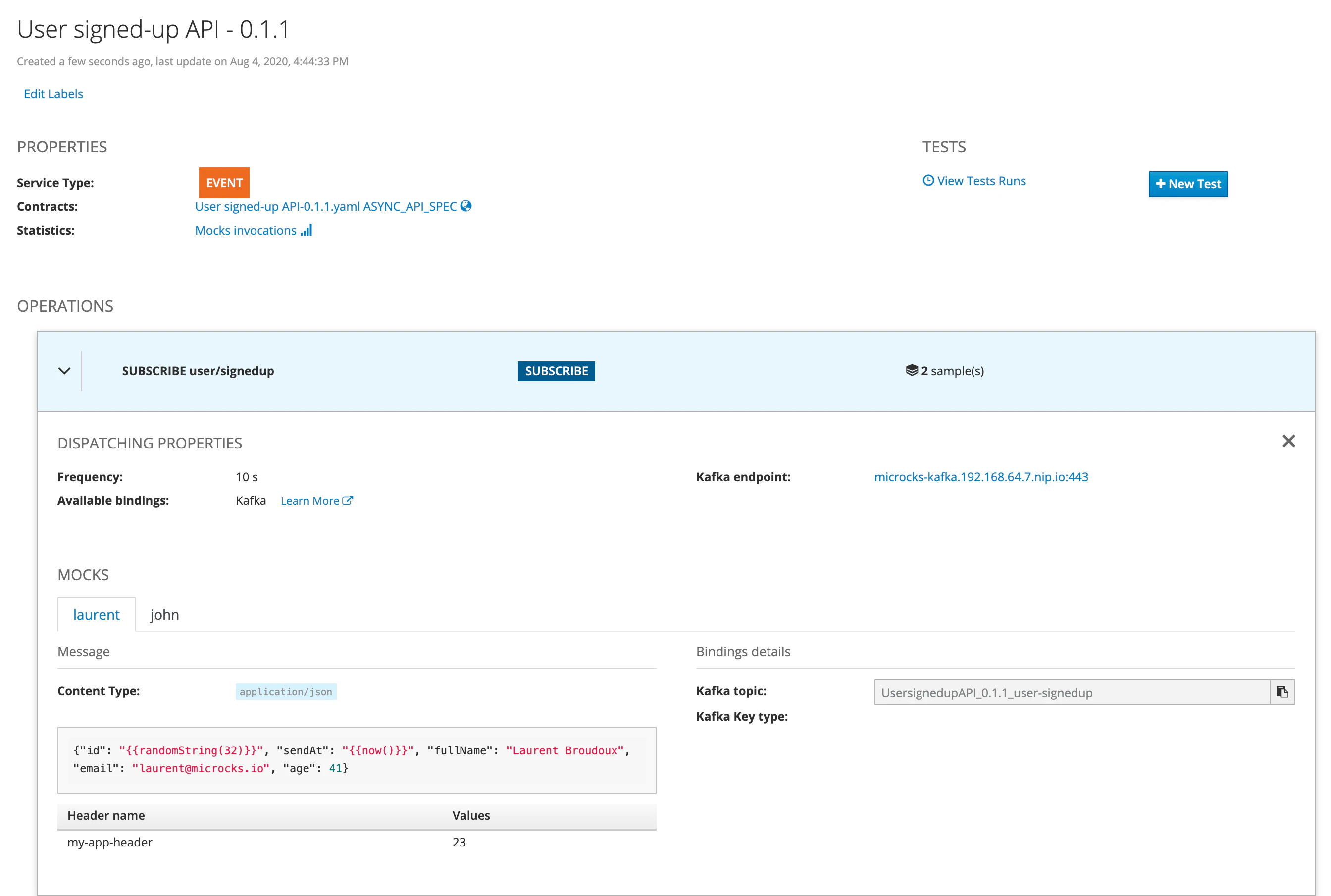-
Using
- Importing Services & APIs
- Comparison to alternatives
- OpenAPI Mocking and Testing
- Swagger Mocking and Testing
- AsyncAPI Mocking and Testing
- Postman usage for Microcks
- gRPC Mocking and Testing
- GraphQL Mocking and Testing
- SoapUI Mocking and Testing
- Http Archive usage for Microcks
- Using exposed mocks
- Getting direct API
- Testing with Microcks
- Advanced topics
- Organizing repository
- Templating mock responses
- Dispatcher & dispatching rules
- Microcks APIMetadata
- Monitoring & Observability
- Installing
- Automating
- Administrating
- Guides
AsyncAPI Mocking and Testing
🗓️ Last updated on March 7, 2024 | 7 | Improve this pageOverview
Introduction
AsyncAPI is an open source initiative that seeks to improve the current state of Event-Driven Architectures (EDA). Its long-term goal is to make working with EDA’s as easy as it is to work with REST APIs. That goes from documentation to code generation, from discovery to event management. Most of the processes you apply to your REST APIs nowadays would be applicable to your event-driven/asynchronous APIs too. So Microcks has support for AsyncAPI too 😉!
Microcks is able to:
- Mock the API by publishing samples messages on a dedicated message broker destinations,
- Test the API by collecting messages on a broker (not necessarily the one used for mocking) and validate them against the schema information found in an AsyncAPI spec.
Starting with release
1.9.0, Microcks supports both AsyncAPI version2.xand version3.x.
Bindings
AsyncAPI specification dissociates the concern of message description (through payload and headers schemas) from the concern of servers and protocol bindings. A same API may have different bindings allowing to specify protocol specific issues like queue or topic naming, serialization format and so on.
At the time of
1.7.1release, Microcks supports theKAFKA, theMQTT, theWS(for WebSocket), theAMQP, theNATS, theGOOGLEPUBSUB, theSQSand theSNSbindings. When setting up Microcks, you have the choice deploying a new Kafka broker as part of the Microcks installation or reusing an existing broker. Any other broker type must be provisioned independantly.
If you don’t explicitly define a binding into your AsyncAPI document, the default KAFKA is appplied. If you specify one or many bindings, Microcks will only publish messages for the ones defined in the AsyncAPI specification.
Conventions
With AsyncAPI Messages Objects
you have the ability to define examples with your AsyncAPI specification document.
Microcks reuses these examples as sample messages for mocking purpose.
For AsyncAPI 2.x document, the name attribute of example is mandatory so that Microcks reuses this name to identify available mock messages. Starting with AsyncAPI 3.0, the name is no longer mandatory and Microcks can then compute a name for you based on the message name and the index of example in the list.
For each version of an API managed by Microcks, it will create appropriate destination for operations in mixing specification elements, protocol binding specifics and versioning issues. Destination managed by Microcks are then referenced within the API details page.
Illustration
We will illustrate how Microcks is using OpenAPI specification through a User signed-up API sample that is inspired by one of AsyncAPI tutorial. The specification file in YAML format can be found here
. This is a single SUBSCRIBE operation API that defines the format of events that are published when a User signed-up an application.
Specifying samples messages
Sample messages are defined within your specification document, simply using the examples attribute like marked below:
channels:
user/signedup:
description: The topic on which user signed up events may be consumed
subscribe:
summary: Receive informations about user signed up
operationId: receivedUserSIgnedUp
message:
description: An event describing that a user just signed up.
traits:
- $ref: '#/components/messageTraits/commonHeaders'
payload:
[...]
examples: # <= Where we'll define sample messages for this operation
Examples will be an array of example objects, starting with a key that Microcks will simply use as the example name. They may include a summary attribute to provide a short description.
Payload
Payload is expressed into the mandatory payload attribute, directly in YAML or by embedding JSON. In our illustration, we will define below 2 examples with straightforward summary:
examples:
- name: laurent
summary: Example for Laurent user
payload: |-
{"id": "{{randomString(32)}}", "sendAt": "{{now()}}", "fullName": "Laurent Broudoux", "email": "laurent@microcks.io", "age": 41}
- name: john:
summary: Example for John Doe user
payload:
id: '{{randomString(32)}}'
sendAt: '{{now()}}'
fullName: John Doe
email: john@microcks.io
age: 36
You can see here that we’re using specific
{{ }}notation that involves the generation of dynamic content. You can find description of thenow()andrandomString()functions into Function Expressions documentation.
Headers
Headers are expressed into the optional headers attribute, directly in YAML or by embedding JSON. In our illustration, we will define below 2 examples using both methods:
examples:
- name: laurent
[...]
headers: |-
{"my-app-header": 23}
- name: john
[...]
headers:
my-app-header: 24
Channel/endpoint names
Given the following AsyncAPI specfiication:
asyncapi: '2.1.0'
info:
title: User signed-up API
version: 0.1.1
description: This service is in charge of processing user signups
channels:
user/signedup:
subscribe:
Microcks will detect an operation named SUBSCRIBE user/signedup and create destinations than integrates service name and version, channel name and protocol specific formmatting. For example, it will create a Kafka topic named UsersignedupAPI-0.1.1-user-signedup or a WebScoket endpoint named /ws/User+signed-up+API/0.1.1/user/signedup. Destination and endpoint names for the different protocols are available on the page presenting API details.
Parameter support
Microcks supports templatized channel endpoints using parameter like {id} in their name. Support of parameter for AsyncAPI 2.x presents some restriction though.
AsyncAPI v2.x
Microcks only supports static parameter definition for AsyncAPI v2.x. That means that for a parameter, you also need to specify the possible different values with examples.
Let’s imagine a basic Chat Room channel. In order to have the different msesages (Example 1, Example 2 and Example 3) dispatched on different rooms, you’ll have to define the different values for the roomId parameter for those example. Like illustrated below:
channels:
/chat/{roomId}:
parameters:
idRoom:
description: Identifier of the chat room
schema:
type: string
examples:
Example 1:
value: 1
Example 2:
value: 2
Example 3:
value: 2
[...]
components:
messages:
chatMessage:
payload:
$ref: '#/components/schemas/ChatMessageType'
examples:
- name: Example 1
payload:
message: Hello
- name: Example 2
payload:
message: Bonjour
- name: Example 3
payload:
message: Namaste
AsyncAPI v3.x
For AsyncAPI v3.x, Microcks still supports static parameter definition like for AsyncAPI v2.X but also provides support for dynamic parameter definition using the location attribute.
Let’s reuse our basic Chat Room channel. The location attribute allows directly retrieving the roomId value from the message payload so that you don’t have to specify alues for the parameter. Also, as Microcks supports AsyncAPI v3 examples without names, the examples no longer need to have name attributes in that case (because we don’t need a key to match payload and parameter values).
channels:
chatRoom:
address: /chat/{roomId}
parameters:
idRoom:
description: Identifier of the chat room
location: $message.payload#/roomId
[...]
components:
messages:
chatMessage:
payload:
$ref: '#/components/schemas/ChatMessageType'
examples:
- payload:
message: Hello
room: 1
- payload:
message: Bonjour
room: 2
- payload:
message: Namaste
room: 2
Importing AsyncAPI specification
When you’re happy with your API design and example definitions just put the result YAML or JSON file into your favorite Source Configuration Management tool, grab the URL of the file corresponding to the branch you want to use and add it as a regular Job import into Microcks. On import, Microcks should detect that it’s an AsyncAPI specification file and choose the correct importer.
Using the above User signed-up API example, you should get the following results:

Using AsyncAPI extensions
Microcks proposes custom AsyncAPI extensions to specify mocks organizational or behavioral elements that cannot be deduced directly from AsyncAPI document.
At the info level of your AsyncAPI document, you can add labels specifications that will be used in organizing the Microcks repository
. See below illustration and the use of x-microcks extension:
asyncapi: '2.1.0'
info:
title: User signed-up API
version: 0.1.1
description: This service is in charge of processing user signups
x-microcks:
labels:
domain: authentication
status: GA
team: Team B
[...]
At the operation level of your AsyncAPI document, we could add frequency that is the interval of time in seconds between 2 publications of mock messages.. Let’s give an example for OpenAPI using the x-microcks-operation extension:
[...]
channels:
user/signedup:
subscribe:
x-microcks-operation:
frequency: 30
message:
$ref: '#/components/messages/UserSignedUp'
[...]
In AsyncAPI v3.x, operation are now differentiated from channels. Our extension is still called x-microcks-operation and should live at the operation level like illustrated below:
[...]
channels:
user-signedup:
messages:
userSignedUp:
$ref: '#/components/messages/userSignedUp'
operations:
publishUserSignedUps:
action: 'send'
channel:
$ref: '#/channels/user-signedup'
messages:
- $ref: '#/channels/user-signedup/messages/userSignedUp'
x-microcks-operation:
frequency: 30
[...]
Once labels and frequency are defined that way, they will overwrite the different customizations you may have done through UI or API during the next import of the AsyncAPI document.

Still Didn’t Find Your Answer?
Join our community and get the help you need. Engage with other members, ask questions, and share knowledge to resolve your queries and expand your understanding.
Join the community